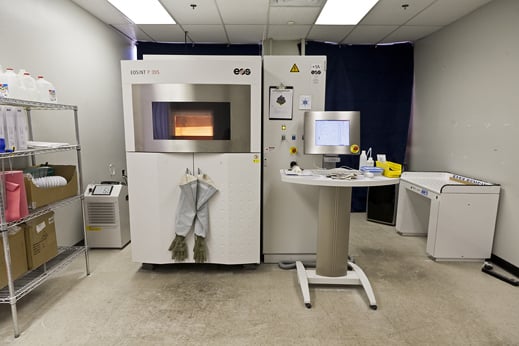Because the technology is only now ramping up (after a twenty year gestation) the results are still a bit crude.Here's MIT's Technology Review making the same point I did, but better, backwards and in heels:
As advances are made in sintering there will eventually be stuff made, not prototypes but actual stuff, from steel or copper or...
Two European companies — EOS of Germany and Arcam of Sweden are ahead of the pack in the metalworking part of the biz....
Fans of 3-D printers and digital design tools argue that these technologies will transform the way we make goods. But can the “maker” movement really produce more than iPhone covers and jewelry?

This Shapeways 3-D printer is working from a digital design to create an object out of nylon.
It’s not surprising that 3-D printing has captured the imagination of so many technologists. Create a digital design file or download one from numerous sites now on the Web, adjust a few settings, hit “Make,” and a machine will slowly print the thing, precisely depositing ultrathin layers of a material (usually a cheap plastic) until the object of your design sits before you. It’s a function instantly recognizable to any reader of science fiction.See also:
The basic technology has existed for decades: a group of engineers at MIT patented “three-dimensional printing techniques” in the early 1990s. Companies such as General Electric have used additive manufacturing, as industrial versions of the technology are often called, to make prototypes and complex parts for airplane turbines and medical instruments. But the real cause of excitement is the emergence of 3-D printers that are affordable for consumers—at least those with a thousand dollars or more to spend.
The seemingly magical ability to “turn bits into atoms,” as advocates like to say, has made 3-D printers iconic tools for a growing number of people intent on do-it-yourself manufacturing. Depending on whom you choose to believe, they are comparable to the first affordable personal computers in the early 1980s—or to the Internet itself.
In Makers: The New Industrial Revolution, Chris Anderson describes the swelling community of people determined to create their own stuff using 3-D printers, laser cutters, advanced design tools, and open-source hardware. Anderson, who until a few months ago was the editor in chief of Wired magazine, describes the “maker movement” with unabashed enthusiasm, pointing to the proliferation of “makerspaces” in which people can use shared facilities and equipment to fabricate their designs and describing popular gatherings called Maker Faires, including an annual event attended by some 100,000 people in the Silicon Valley city of San Mateo, California. In Queens, directly across the East River from midtown Manhattan, a company called Shapeways has created what it calls the “Factory of the Future,” equipped with some 30 industrial-size 3-D printers to produce the various designs of its digital customers....MORE
Stratasys as the Leader in the 3D Printing Industry (SSYS; DDD)
Climateer Headline du Jour: Nazi buddha from space might be fake Edition